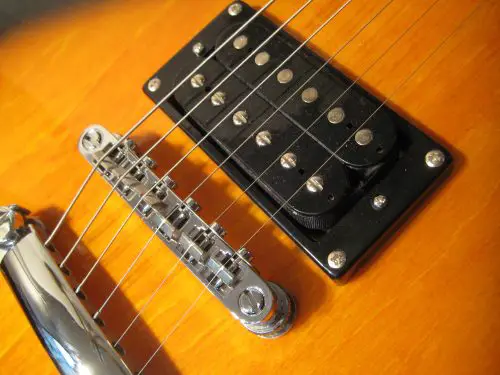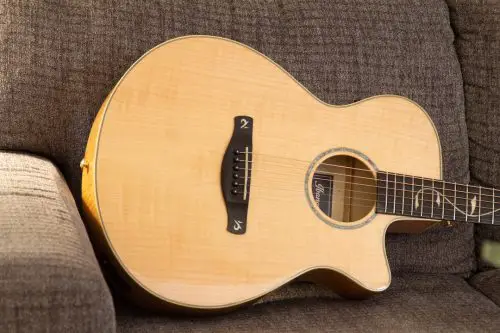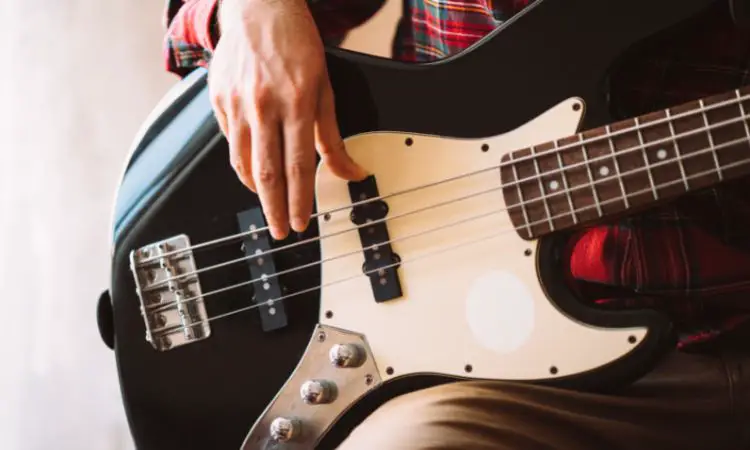The bridge on a guitar is not straight because it needs to compensate for the different string lengths and thicknesses. Each string on a guitar has a different diameter and tension, which affects its pitch and tone. By angling the bridge, it allows for the adjustment of string length to achieve proper intonation across all of the strings.
The primary purpose of the bridge on a guitar is to transmit the vibrations from the strings to the body of the instrument, while also supporting the strings at the correct height. If the bridge were straight, the string lengths would be longer for the thicker and shorter for the thinner strings. This would cause issues with intonation, making certain notes sound out of tune.
By angling the bridge, the string lengths can be adjusted individually to compensate for their varying thicknesses and tensions. This allows the guitarist to achieve proper intonation, where each note played on different frets is in tune with one another. It also allows for adjusting the action of the strings, which is the distance between the strings and the fretboard, to provide comfort and ease of playing.
The angle of the bridge can be adjusted by raising or lowering its height. This is typically done by adjusting the screws or bolts on either side of the bridge. These adjustments can affect the playability and sound of the instrument.
A higher action can make it easier for the strings to be bent, providing more expressive playing, but can also make it harder to press down the strings for beginners or players with weaker fingers. Conversely, a lower action can make it easier to press down the strings but may cause buzzing or fretting out when playing with a heavy attack.
In addition to compensating for string length and height, the bridge on some guitars may also have individual saddle pieces. These saddles allow for further adjustment of intonation for each string. By using a small Allen wrench or screwdriver, the saddle can be moved forward or backward to fine-tune the intonation of each string.
Here’s a summary that sums up the entire article if you are too busy. Otherwise, read till the end because there are much more to the topic!
| Topic | Answer |
|---|---|
| Why is the bridge on a guitar not straight? | The bridge on a guitar is angled to compensate for different string lengths and thicknesses, allowing for proper intonation and playability. |
| Is the bridge of the guitar supposed to be straight? | No, the bridge of a guitar is intentionally angled to achieve proper intonation and adjust the action of the strings. |
| How do you straighten a guitar bridge? | Loosen the strings, adjust the bridge height, re-tune and test. However, major adjustments are best done by a professional technician. |
| Can adjusting the bridge on a guitar affect the tone? | Yes, adjusting the bridge can impact the overall tone by changing string tension, break angle, and resonance. |
| Why is intonation important on a guitar? | Intonation ensures the guitar plays in tune across all frets, resulting in clear and harmonically pleasing tones. |
| Can changing string gauge affect the guitar’s bridge? | Yes, changing string gauge can impact the tension on the bridge, potentially causing it to tilt or require adjustments. |
Is the bridge of the guitar supposed to be straight?

The bridge of a guitar is not supposed to be straight. It is intentionally angled to compensate for the varying string lengths and thicknesses. If the bridge were straight, the string lengths would be uneven, causing issues with intonation.
By angling the bridge, each string can have its length adjusted individually, allowing for proper intonation across all strings. This means that when a note is played on different frets, it will be in tune with the other notes.
In addition to intonation, the angled bridge also affects the action of the strings. The action is the distance between the strings and the fretboard. By adjusting the height of the bridge, the action can be modified.
A higher action can make it easier to bend the strings, providing more expressive playing, but can also require more strength to press down the strings. On the other hand, a lower action may make it easier to press down the strings, but can potentially cause buzzing or fretting out when playing with a heavy attack.
The angle of the bridge can be adjusted by raising or lowering its height. This is usually done by adjusting screws or bolts located on either side of the bridge. These adjustments may require some trial and error to find the ideal setup for each guitarist’s playing style and preferences.
It’s important to note that the design and setup of the bridge can vary depending on the type of guitar. Acoustic guitars commonly have a fixed bridge, while electric guitars may have a fixed, tremolo, or floating bridge. Each type of bridge has its own considerations for string height and intonation adjustment.
Can adjusting the bridge on a guitar affect the tone?
Adjusting the bridge on a guitar can indeed affect the tone. The position, height, and angle of the bridge can all play a role in shaping the overall sound of the instrument.
When adjusting the bridge height, raising or lowering it can impact the string tension and how the strings vibrate. A lower bridge can result in a looser feel and a slightly warmer tone, while a higher bridge can provide more tension and brightness to the sound. These adjustments can help tailor the instrument’s tone to match personal preferences or specific playing styles.
Moreover, the angle of the bridge can impact the contact point between the strings and the bridge saddles. Adjusting the angle can alter the degree of string break angle, which affects sustain, resonance, and tonal characteristics. A steeper break angle can increase sustain and enhance low-end response, while a shallower angle can provide a brighter and snappier tone.
Additionally, fine-tuning the intonation through bridge adjustments can impact the overall sound. Proper intonation ensures that the notes played on different frets are in tune with each other. If the bridge is not adjusted correctly, the guitar may sound out of tune, especially when playing chords or bending strings.
It is important to note that while adjusting the bridge can have an impact on the tone, it is just one element among many others that contribute to the overall sound of a guitar. Factors like the type of wood, pickups (on electric guitars), strings, and playing technique also play pivotal roles in shaping the instrument’s tone.
Experimenting with bridge adjustments can be a fun and creative way for guitarists to explore different tonal possibilities and fine-tune their instrument’s sound to suit their preferences. It is always recommended to make adjustments gradually and carefully, or consult with a professional guitar technician if unsure, to avoid any potential damage to the instrument.
Also Read: Understanding How Guitar Bridges Impact Tuning and Tone
How do you straighten a guitar bridge anyway?

Straightening a guitar bridge can be a delicate process and should be approached with caution to avoid damaging the instrument. However, it is possible to make minor adjustments to the bridge if necessary. Here are some steps to follow to straighten a guitar bridge:
1. Assess the bridge: Before making any adjustments, examine the bridge to determine if it is truly misaligned. Look for signs of uneven string height or angling. If you are unsure, it may be best to consult a professional guitar technician.
2. Loosen the strings: To make adjustments to the bridge, it is essential to loosen the tension on the strings. You can do this by turning the tuning pegs slowly until the strings are slack. Be careful not to release the tension too quickly, as it can cause damage to the instrument or injure the player.
3. Adjust the bridge height: If the bridge needs straightening due to height discrepancies, you can raise or lower it accordingly. Most bridges have screws or bolts on either side that can be adjusted to modify the height. Use a small Allen wrench or screwdriver to turn these screws or bolts in small increments. Make sure to maintain equal adjustment on both sides to keep the bridge centered.
4. Re-tune and test: After making adjustments to the bridge, re-tune the guitar to the desired pitch. Play across the fretboard and listen for any buzzing or intonation issues. If there are still problems, you may need to revisit the adjustment and make further modifications.
It is crucial to note that significant adjustments to the bridge should be done by a professional guitar technician. Attempting to straighten the bridge without proper knowledge and tools may lead to irreversible damage to the instrument. Additionally, some types of bridges, such as floating or tremolo bridges, may require specialized techniques and adjustments that are best left to professionals.
Consulting a guitar technician or luthier is always recommended if you are unsure about adjusting the bridge yourself. They have the expertise and experience to ensure that your guitar is set up properly and in optimal playing condition.
Can changing string gauge affect the guitar’s bridge?
Changing the string gauge on a guitar can potentially affect the guitar’s bridge. The bridge is designed to accommodate specific string gauges, and altering the gauge can have implications on the tension and overall setup of the instrument.
When changing to a heavier gauge string, which has a larger diameter and higher tension, the increased tension can exert more force on the bridge. This can result in the bridge being pulled up or tilted forward, causing it to lift away from its original position.
On the other hand, switching to a lighter gauge string, which has a smaller diameter and lower tension, may not provide enough tension to fully stabilize the bridge, leading to a potential decrease in string height (action) and altered intonation.
The adjustment required to accommodate a different string gauge will depend on the specific guitar and its setup. In some cases, a simple truss rod adjustment or bridge height adjustment may be sufficient to compensate for the change in tension. However, more significant changes in string gauge may require additional adjustments such as modifying the bridge saddle height or possibly replacing the bridge altogether to ensure proper alignment and intonation.
It is important to note that any adjustments or modifications to the bridge should be done carefully and preferably by a professional guitar technician or luthier. They have the knowledge and experience to assess the instrument and make the necessary adjustments to maintain its playability, intonation, and overall structural integrity.
Additionally, it is worth considering that changing the string gauge can also affect other components of the guitar, such as the nut slots and the truss rod. Heavier gauge strings may require the nut slots to be widened to accommodate the thicker strings, while lighter gauge strings may require the opposite. The truss rod may also need adjustment to compensate for the different tension and bow of the neck caused by the change in string gauge.
Before changing the string gauge, it is advisable to consult with a guitar technician or luthier to ensure that the adjustments are properly made to maintain the optimal performance and playability of the instrument. They can help determine the best course of action and ensure that any modifications to the bridge or other components are done correctly.
Also Read: Beginner’s Guide: The Easiest String Gauge for Your Guitar
Summary
In conclusion, the angled bridge on a guitar serves a crucial purpose in maintaining proper intonation and playability. It compensates for the varying lengths and thicknesses of the strings, allowing for each string to be individually adjusted. This ensures that the notes played on different frets are in tune with each other and creates a harmonious musical experience.
While adjusting the bridge may require some skill and expertise, it provides an opportunity to fine-tune the instrument to match personal preferences and playing styles. The height and angle adjustments can affect the tone and overall feel of the guitar, allowing for a customized playing experience.
Remember, the bridge is just one piece of the puzzle that contributes to the sound and performance of a guitar. Factors such as the type of wood, pickups, and strings also play a role. So, don’t be afraid to explore and experiment with adjustments, but when in doubt, it’s always wise to seek the guidance of a professional technician who can ensure that your guitar is perfectly set up for you to rock on! Happy strumming!






